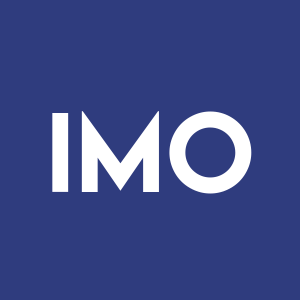Imperial announces first quarter 2021 financial and operating results
Imperial Oil Limited (TSX, NYSEAM: IMO):
-
Net income of
$392 million in the first quarter of 2021 -
Cash flows from operating activities of over
$1 billion in the first quarter - Improved financial performance across all business segments compared to the fourth quarter
- Highest first quarter Upstream production in 30 years, driven by record gross production at Kearl
- Imperial reinstates significant share purchase program with plans to purchase up to four percent of outstanding common shares by June 28, 2021
-
Quarterly dividend raised by almost
23% from 22 cents to 27 cents per share
|
First quarter |
|||||
millions of Canadian dollars, unless noted |
2021 |
2020 |
∆ |
|||
Net Income (loss) (U.S. GAAP) |
392 |
|
(188) |
|
+580 |
|
Net Income (loss) per common share, assuming dilution (dollars) |
0.53 |
|
(0.25) |
|
+0.78 |
|
Capital and exploration expenditures |
163 |
|
331 |
|
-168 |
|
Imperial reported estimated net income of
During the first quarter of 2021, the company generated cash flow from operating activities of
“Imperial took decisive actions to weather the economic storm throughout 2020, including making fundamental improvements to its cost structure and continuing to progress key projects to ensure the company was well positioned to take full advantage of market conditions as they began to improve,” said Brad Corson, chairman, president and chief executive officer. “The benefits of this approach underpin our strong performance this quarter. I am extremely proud of our ability to deliver these results while also meeting our commitments to the care of our people, communities, and the environment.”
Upstream production for the first quarter averaged 432,000 gross oil-equivalent barrels per day, the highest first quarter production in 30 years. Kearl total gross production averaged 251,000 barrels per day, establishing a new production record for each month of the first quarter.
Downstream throughput averaged 364,000 barrels per day in the first quarter, with utilization at 85 percent, up from 359,000 barrels per day in the fourth quarter of 2020. Petroleum product sales were 414,000 barrels per day, compared to 416,000 barrels per day in the fourth quarter of 2020. Despite continuing weak demand, Downstream generated net income of
Consistent with the company’s long-standing commitment to shareholders, Imperial amended its current share purchase program and plans to purchase up to four percent of outstanding common shares (as of June 15, 2020) by June 28, 2021. Additionally, Imperial declared a second quarter dividend of 27 cents per share, an increase of almost 23 percent. “These actions reflect the company’s strong financial performance and confidence in its future, and demonstrate our ongoing commitment to return cash to shareholders,” Corson added.
First quarter highlights
-
Net income of
$392 million or$0.53 per share on a diluted basis, compared to net loss of$188 million or$0.25 per share in the first quarter of 2020. Net income excluding identified items1 of$392 million in the first quarter of 2021, up from$93 million in the same period of 2020. -
Cash flows from operating activities of
$1,045 million , up from$423 million in the same period of 2020. Cash flows from operating activities excluding working capital1 of$1,068 million , up from$611 million in the same period of 2020. -
Capital and exploration expenditures totalled
$163 million , compared to$331 million in the first quarter of 2020. The company continues to anticipate full-year capital and exploration expenditures of$1.2 billion in 2021. -
Dividends paid totalled
$162 million or$0.22 per share, compared to$164 million or$0.22 per share in the first quarter of 2020. - Increased share purchase program underpinned by strong financial position. In April, the program was amended to allow Imperial to purchase up to four percent of its common shares outstanding (as of June 15, 2020), approximately 29,363,070 shares, during a 2-month period ending June 28, 2021. Consistent with the company’s balance sheet strength, low capital requirements and strong cash generation, this amendment reflects the company’s priority and capacity to return cash to shareholders.
- Production averaged 432,000 gross oil-equivalent barrels per day, up from 419,000 barrels per day in the same period of 2020.
- Total gross production at Kearl averaged 251,000 barrels per day (178,000 barrels Imperial's share), up from 226,000 barrels per day (160,000 barrels Imperial's share) in the first quarter of 2020. The asset established new production records for each month of the first quarter, with higher production primarily driven by supplemental crushing facilities.
- Gross bitumen production at Cold Lake averaged 140,000 barrels per day, in line with 140,000 barrels per day in the first quarter of 2020.
- The company's share of gross production from Syncrude averaged 79,000 barrels per day, up from 73,000 barrels per day in the first quarter of 2020.
- Refinery throughput averaged 364,000 barrels per day, compared to 383,000 barrels per day in the first quarter of 2020. Capacity utilization was 85 percent, compared to 91 percent in the first quarter of 2020. Lower refinery throughput was primarily driven by lower market demand due to the COVID-19 pandemic.
- Petroleum product sales were 414,000 barrels per day, compared to 462,000 barrels per day in the first quarter of 2020. Lower petroleum product sales were primarily driven by reduced demand due to the COVID-19 pandemic.
-
Chemical net income of
$67 million in the quarter, up from$21 million in the first quarter of 2020. -
The Liquid Addition to Steam for Enhanced Recovery (LASER) Project at Cold Lake's Mahkeses plant successfully started up. This latest deployment of Imperial’s enhanced recovery solvent technology improves productivity and is expected to enable up to a
25% greenhouse gas intensity reduction for the associated production. - Imperial released its updated Corporate Sustainability Report. The update highlights the company’s actions and results across key dimensions of sustainability. The report’s expanded climate section includes scope 3 emissions estimates and outlines Imperial's efforts to develop pathways in support of a net-zero future.
-
Imperial provided an additional
$2.5 million in free fuel to 100,000 frontline health care workers in recognition of their tireless service. This is the second Health Care Heroes campaign initiated by Imperial during the pandemic;$2 million in free fuel cards were provided to 80,000 health care workers in 2020.
1 non-GAAP measure - See Attachment VI for definition and reconciliation |
First quarter 2021 vs. first quarter 2020
In early 2020, the balance of supply and demand for petroleum and petrochemical products experienced two significant disruptive effects. On the demand side, the COVID-19 pandemic spread rapidly through most areas of the world resulting in substantial reductions in consumer and business activity and significantly reduced demand for crude oil, natural gas, and petroleum products. This reduction in demand coincided with announcements of increased production in certain key oil-producing countries which led to increases in inventory levels and sharp declines in prices for crude oil, natural gas, and petroleum products.
While demand has rebounded considerably, the lingering effects of the weak 2020 business environment has continued to have a negative impact on financial results in 2021 when compared to periods prior to the pandemic. Signs of improvement are emerging including higher crude and gas prices through the quarter and stronger Downstream and Chemical margins.
The company recorded net income of
Upstream recorded net income of
West Texas Intermediate (WTI) averaged US
The Canadian dollar averaged US
Imperial’s average Canadian dollar realizations for bitumen increased in the quarter, primarily due to an increase in WCS. Bitumen realizations averaged
Total gross production of Kearl bitumen averaged 251,000 barrels per day in the first quarter (178,000 barrels Imperial’s share), up from 226,000 barrels per day (160,000 barrels Imperial’s share) in the first quarter of 2020. Higher production was primarily driven by the supplemental crushing facilities.
Gross production of Cold Lake bitumen averaged 140,000 barrels per day in the first quarter, in line with 140,000 barrels per day in the same period of 2020.
The company's share of gross production from Syncrude averaged 79,000 barrels per day, up from 73,000 barrels per day in the first quarter of 2020.
Downstream recorded net income of
Refinery throughput averaged 364,000 barrels per day, compared to 383,000 barrels per day in the first quarter of 2020. Capacity utilization was 85 percent, compared to 91 percent in the first quarter of 2020. Lower refinery throughput was primarily driven by lower market demand due to the COVID-19 pandemic.
Petroleum product sales were 414,000 barrels per day, compared to 462,000 barrels per day in the first quarter of 2020. Lower petroleum product sales were primarily driven by reduced demand due to the COVID-19 pandemic.
Chemical net income was
Corporate and other expenses were
Cash flow generated from operating activities was
Investing activities used net cash of
Cash used in financing activities was
The company’s cash balance was
At March 31, 2021, due to the termination of transportation services agreements related to a third-party pipeline project, the company recognized a liability of
On April 30, 2021, the company announced an amendment to its normal course issuer bid to increase the number of common shares that it may purchase. Under the amendment, the number of common shares that may be purchased will increase to a maximum of 29,363,070 common shares during the period June 29, 2020 to June 28, 2021, which includes shares purchased under the normal course issuer bid and from Exxon Mobil Corporation concurrent with, but outside of the normal course issuer bid. No other provisions of the normal course issuer bid have changed. The company currently anticipates maximizing its share purchases under the program. Purchase plans may be modified at any time without prior notice.
Key financial and operating data follow.
Forward-looking statements
Statements of future events or conditions in this report, including projections, targets, expectations, estimates, and business plans are forward-looking statements. Forward-looking statements can be identified by words such as believe, anticipate, intend, propose, plan, goal, seek, project, predict, target, estimate, expect, strategy, outlook, schedule, future, continue, likely, may, should, will and similar references to future periods. Forward-looking statements in this report include, but are not limited to, references to plans for purchases under the company’s amended share purchase program; the company’s low capital requirements, strong cash generation, confidence in its future and the priority and capacity to return cash to shareholders; the commitment to sustainability, including efforts to develop pathways in support of a net-zero future; anticipated full year capital and exploration expenditures of
Forward-looking statements are based on the company's current expectations, estimates, projections and assumptions at the time the statements are made. Actual future financial and operating results, including expectations and assumptions concerning demand growth and energy source, supply and mix; commodity prices, foreign exchange rates and general market conditions; production rates, growth and mix; project plans, timing, costs, technical evaluations and capacities and the company’s ability to effectively execute on these plans and operate its assets; the adoption and impact of new facilities or technologies, including on reductions to greenhouse gas and water intensity; progression of COVID-19 and its impacts on Imperial’s ability to operate its assets, including the possible shutdown of facilities due to COVID-19 outbreaks; the company’s ability to effectively execute on its business continuity plans and pandemic response activities; applicable laws and government policies, including restrictions in response to COVID-19; the company’s ability to achieve cost savings; cash generation, financing sources and capital structure; and capital and environmental expenditures could differ materially depending on a number of factors.
These factors include global, regional or local changes in supply and demand for oil, natural gas, and petroleum and petrochemical products and resulting price, differential and margin impacts, including foreign government action with respect to supply levels and prices and the impact of COVID-19 on demand; availability and allocation of capital; transportation for accessing markets; availability and performance of third-party service providers, including in light of restrictions related to COVID-19; management effectiveness and disaster response preparedness, including business continuity plans in response to COVID-19; political or regulatory events, including changes in law or government policy such as tax laws, production curtailment and actions in response to COVID-19; the results of research programs and new technologies, and ability to bring new technologies to commercial scale on a cost-competitive basis; environmental risks inherent in oil and gas exploration and production activities; environmental regulation, including climate change and greenhouse gas regulation and changes to such regulation; unanticipated technical or operational difficulties; project management and schedules and timely completion of projects; the receipt, in a timely manner, of regulatory and third-party approvals; operational hazards and risks; cybersecurity incidents, including increased reliance on remote working arrangements and activation of business continuity plans due to COVID-19; currency exchange rates; general economic conditions; and other factors discussed in Item 1A risk factors and Item 7 management’s discussion and analysis of financial condition and results of operations of Imperial Oil Limited’s most recent annual report on Form 10-K.
Forward-looking statements are not guarantees of future performance and involve a number of risks and uncertainties, some that are similar to other oil and gas companies and some that are unique to Imperial Oil Limited. Imperial’s actual results may differ materially from those expressed or implied by its forward-looking statements and readers are cautioned not to place undue reliance on them. Imperial undertakes no obligation to update any forward-looking statements contained herein, except as required by applicable law.
In this release all dollar amounts are expressed in Canadian dollars unless otherwise stated. This release should be read in conjunction with Imperial’s most recent Form 10-K. Note that numbers may not add due to rounding.
The term “project” as used in this release can refer to a variety of different activities and does not necessarily have the same meaning as in any government payment transparency reports.
|
|
|
Attachment I |
||
|
|
|
|
|
|
|
|
|
|
|
|
|
|
Three Months |
|||
millions of Canadian dollars, unless noted |
|
|
2021 |
|
2020 |
|
|
|
|
|
|
Net Income (loss) (U.S. GAAP) |
|
|
|
|
|
Total revenues and other income |
|
|
6,998 |
6,690 |
|
Total expenses |
|
|
6,486 |
6,945 |
|
Income (loss) before income taxes |
|
|
512 |
(255) |
|
Income taxes |
|
|
120 |
(67) |
|
Net income (loss) |
|
|
392 |
(188) |
|
|
|
|
|
|
|
Net income (loss) per common share (dollars) |
|
|
0.53 |
(0.25) |
|
Net income (loss) per common share - assuming dilution (dollars) |
Imperial Oil
NYSE:IMOIMO RankingsIMO Latest NewsDec 15, 2025
Imperial provides 2026 corporate guidance outlook
Oct 31, 2025
Imperial declares fourth quarter 2025 dividend
Oct 15, 2025
Imperial to hold 2025 Third Quarter Earnings Call
IMO Latest SEC FilingsDec 15, 2025
[8-K] IMPERIAL OIL LTD Reports Material Event
Oct 31, 2025
[8-K] IMPERIAL OIL LTD Reports Material Event
Oct 31, 2025
[8-K] IMPERIAL OIL LTD Reports Material Event
IMO Stock Data | ||||








